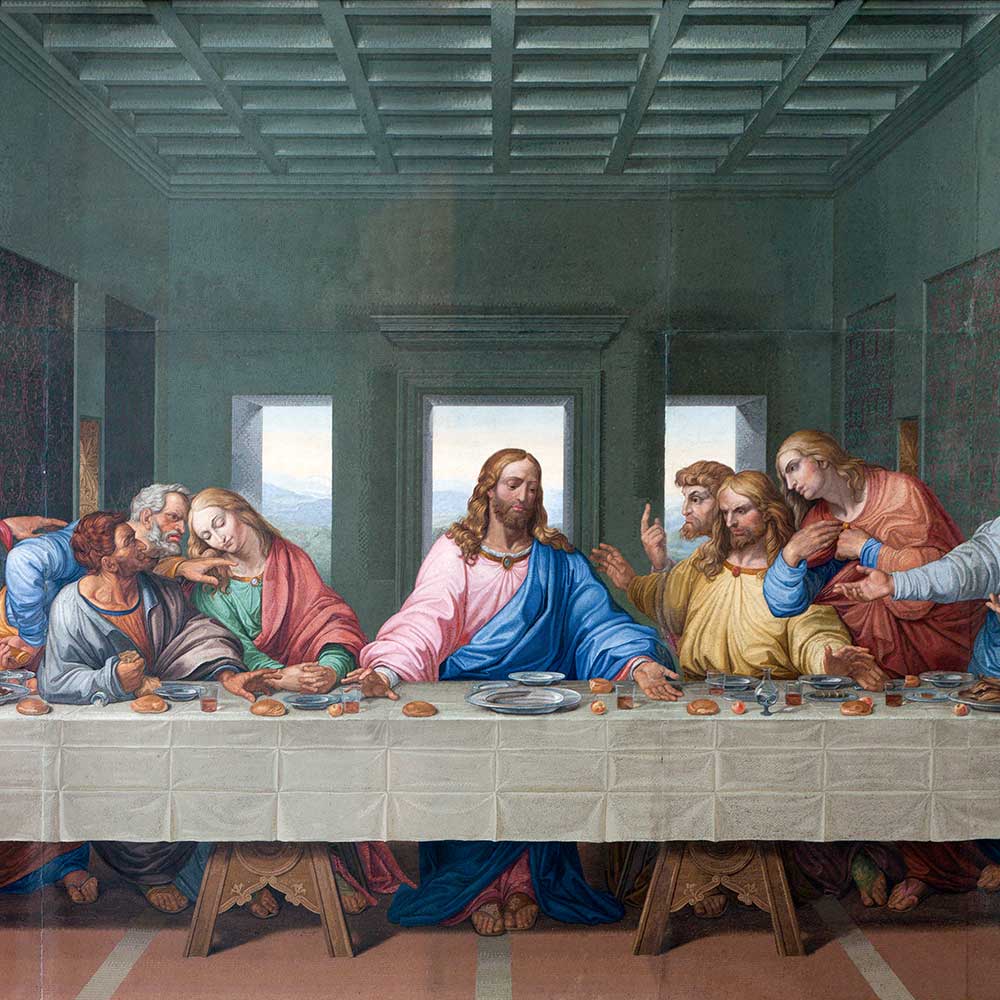
The Last Supper
The Last Supper was one of the most significant events of the Passion. In the context of human relationships, it was the final gathering of Jesus and the twelve apostles. In the context of our relationship to God, it was the moment of confirmation that Jesus was the bread of life. When he administered the first communion of his body and blood to the apostles, Jesus shared the saving action of the Eucharist.
The Last Supper was also the final act of a mystery that had been playing out for days—the identity of the apostle who would betray Jesus. From scripture (Ps 41:8–9), Jesus knew that a betrayal by one closest to him would lead to his death; however, while he may have been alerted to Judas’s meeting with the temple authorities, the secrecy in which the preparations for the Last Supper were conducted suggests that he had not yet concluded who would ultimately betray him.
Of course, knowing what was to come (his arrest, trial, and crucifixion) begs the question: If Jesus knew his death was imminent, would he not have also known the identity of his betrayer? Could Jesus, through divine revelation, have been privy to that information? The answer is yes, he certainly could have; however, as evidenced in countless examples throughout the Bible, God works through human agents. He does not normally, and unnecessarily, work as the deus ex machina.
Who were those human agents who might have identified Judas? We can look to the temple bureaucracy as a possibility. Two members of the Sanhedrin—Nicodemus and Joseph of Arimathea—secretly sympathized with Jesus. Undoubtedly, there were others within the temple hierarchy, from priests down to menial workers, who quietly followed his teachings. If one had warned Jesus that Judas had met with Caiaphas, this news would have likely filled Jesus with concern. Still, at the time the Last Supper, it appears that Jesus was not yet convinced of Judas’s duplicity.
If not Judas, then whom? There was another apostle Jesus may have suspected: James, the son of Zebedee and brother of the apostle John. Once a member of Jesus’s trusted inner circle with Peter and John, James had strained his relationship with Jesus days earlier with his attempted “coup” against Peter. At the urging of his mother, Salome, James had pressed for the top positions in Jesus’s new kingdom on earth for himself and his brother. Jesus had rebuked him. Could James have been disgruntled enough to turn Jesus over to the Sanhedrin?
Clandestine Meetings
It appears that Jesus did have some doubt about James. We know this because, as preparations for the meal were set in motion, James was never mentioned. Only three people were aware of the timing and location of the meal: Peter, John, and the householder of the secret location.
We must remember that preparing the Passover meal was not a simple task. Passover was the most important day of observance for the Jewish people, and preparations involved cleaning the leaven out of the house and gathering bitter herbs and other ingredients. It also included the killing of a lamb, an act usually done by a temple priest but, in this case, presumably assigned to Peter and John.
Jesus also pre-arranged with the householder that a man would meet some disciples and lead them to the house to prepare the Passover meal. He would be identified by the jar of water he carried—an unusual sight since that was a woman’s work. Jesus waited until the last minute and then sent Peter and John to meet the man. As they were his most trusted disciples, there was little chance the betrayer could ascertain the location and alert the temple authorities.
Unorthodox Timing
For Jesus, the imminent betrayal could not interfere with his plans for this last Passover meal. It was during the supper that he intended to institute the Eucharist, leaving the apostles with a sacred ritual that would, along with scripture and prayer, form the basis of the Mass we know today. He knew that the betrayal would have to occur before the Passover holidays. The temple hierarchy needed to arrest and execute him before the actual feast. If they did not, they would be required to wait a week for the Feast of Unleavened Bread to end, and such a delay could allow a much-feared insurrection to take place.
Therefore, Jesus gave directions to prepare the meal at least a day in advance. While this request must have mystified the householder, it was done in secret. Although it was not held in accordance to the actual Passover feast time, Jesus was Lord of the sabbath and Lord of the Passover; he could, therefore, change its timing as the circumstances necessitated.
Hence, when all the preparations had been completed, Jesus led the twelve disciples to the secret location. By waiting until the last possible moment to reveal the meeting-place, he had effectively denied the betrayer any chance of running to the temple authorities. His careful and covert planning had ensured the Last Supper would take place.
Secret Location
Who was the householder? In all likelihood the house belonged to Mary, the mother of John Mark (author of Mark). Her husband was most likely dead as the house was referred to as “the house of Mary” in Acts. Also, to support the claim of Mary’s house as the location, Mark tells us that a young man accompanied Jesus and the disciples to Gethsemane, one who was not present at the Last Supper but was a member of the household. John Mark is traditionally believed to be this unidentified young man (age twelve) who escaped at Gethsemane by slipping out of his linen cloak and running off naked.
The meal was held in the upper room of the house. Jesus and the twelve apostles were alone in the room. Mary, her family, her servants, and the women who accompanied and served Jesus and his entourage were present in the house but ate elsewhere when not serving Jesus and the apostles.
Mystery Solved
For the meal, Jesus ordered a strategic seating plan: John would be on one side of him, with Judas at his other side, and Peter directly across from John. We must believe that had Jesus known with certainty prior to the meal that his betrayer was Judas, a seating arrangement would not have been necessary. Instead, it is more likely that Jesus placed Judas next to him to try to ascertain that he was the betrayer.
As we know, during the Last Supper Jesus decided that Satan had “entered into” Judas, whether from Judas’s coldness toward him or otherwise. The mystery was solved, the identity confirmed: Judas Iscariot was indeed the one who would betray him. Realizing this, Jesus sent Judas on his way, saying, “What you are going to do, do quickly.” Hours later, Judas would lead the temple authorities and soldiers to Jesus in the Garden of Gethsemane. The following day, Jesus would die. Judas, full of guilt and despair, would hang himself.
